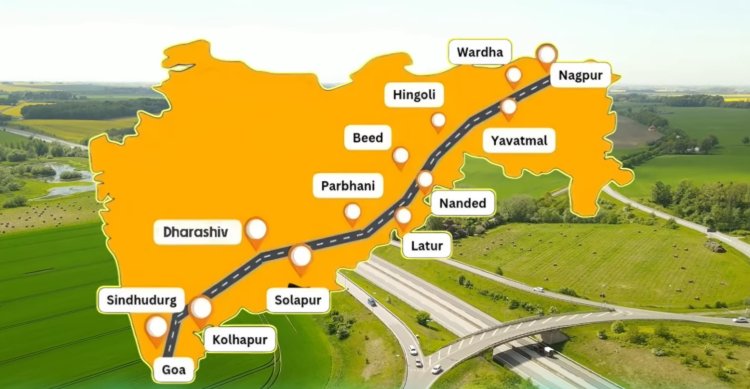Nagpur Goa Expressway: A Road to Spirituality and Growth
The Nagpur Goa Expressway, officially named the Shaktipeeth Expressway, is one of the most ambitious infrastructure projects in Maharashtra, promising to redefine connectivity between Nagpur and Goa. Spanning approximately 802 kilometers, this six-lane, access-controlled expressway is set to cut travel time from 18–20 hours to just 8–10 hours, making it a lifeline for travelers, pilgrims, and businesses alike. For the people of Nagpur, this project is more than just a road—it’s a gateway to economic opportunities, enhanced tourism, and a stronger connection to the cultural and spiritual heritage of Maharashtra and Goa. In this blog, we’ll dive into the details of the Nagpur Goa Expressway, exploring its route, significance, benefits, challenges, and what it means for the future of Nagpur and beyond.
You might like: Newly Developed Areas in Nagpur You Should Know
What is the Nagpur Goa Expressway?
The Nagpur Goa Expressway is a proposed 802-km, six-lane greenfield expressway that will connect Pavnar in Wardha district, near Nagpur, to Patradevi in Sindhudurg district, close to the Maharashtra-Goa border. Managed by the Maharashtra State Road Development Corporation (MSRDC), the project is designed to enhance connectivity across 12 districts in Maharashtra—Wardha, Yavatmal, Hingoli, Nanded, Parbhani, Beed, Latur, Dharashiv, Solapur, Sangli, Kolhapur, and Sindhudurg—before entering North Goa. The expressway is expected to be operational by 2028 or 2029, with a budget of approximately ₹86,300 crore, making it one of India’s most significant infrastructure initiatives.
The name “Shaktipeeth Expressway” comes from its unique alignment, which connects three prominent Shakti Peethas—Mahalakshmi in Kolhapur, Tuljabhavani in Tuljapur, and Renuka Devi in Mahur—along with other sacred sites like the Jyotirlingas at Aundha Nagnath and Parli Vaijnath, and the revered Vithoba Temple in Pandharpur. For Nagpur residents, this expressway will not only make travel to Goa faster but also open up easier access to these spiritual landmarks, boosting religious tourism.
Why the Nagpur Goa Expressway Matters for Nagpur
For the people of Nagpur, the Nagpur Goa Expressway is a project of immense local and regional importance. Nagpur, often called the “Orange City” and a major hub in Vidarbha, has long been a key player in Maharashtra’s economic and cultural landscape. However, its connectivity to coastal regions like Goa has been limited by long travel times and congested routes. The expressway promises to change that by slashing travel time to just 8–10 hours, compared to the current 18–20 hours. This will make weekend getaways to Goa’s beaches, business trips, and pilgrimages far more convenient for Nagpur’s residents.
Beyond convenience, the expressway is expected to spur economic growth in Nagpur. By improving access to Goa’s ports, the project will enhance export-import (EXIM) trade, benefiting local industries such as agriculture, manufacturing, and logistics. Property prices in Nagpur are projected to rise by 20–30% once the expressway is operational, reflecting its potential to transform the city’s real estate market. Additionally, the expressway will create jobs in construction, hospitality, and tourism, offering new opportunities for Nagpur’s youth.
The Route and Key Features of the Nagpur Goa Expressway
The Nagpur Goa Expressway will begin in Pavnar, Wardha district, linking seamlessly with the Mumbai-Nagpur Samruddhi Expressway. From there, it will pass through 12 districts in Maharashtra, covering regions like Vidarbha, Marathwada, and Western Maharashtra, before concluding at Patradevi on the Maharashtra-Goa border. The route is designed to bypass congested cities like Mumbai and Pune, offering a faster and smoother journey. Key districts along the route include:
- Wardha: Home to Pavnar and Sevagram Ashram, a significant historical site.
- Yavatmal: A key agricultural hub in Vidarbha.
- Hingoli and Nanded: Known for the Aundha Nagnath Jyotirlinga and Takht Sachkhand Gurdwara.
- Parbhani and Beed: Including spiritual sites like Ambajogai.
- Latur and Dharashiv: Connecting to Tuljabhavani Temple in Tuljapur.
- Solapur, Sangli, and Kolhapur: Home to the Mahalakshmi Temple and other cultural landmarks.
- Sindhudurg: Ending at Patradevi, near the Goa border.
The expressway will feature 26 interchanges, including Pavnar-Yela, Yavatmal, Hingoli-Nanded, and Parbhani, ensuring easy access to nearby towns and villages. It will also incorporate state-of-the-art technologies like Smart Traffic Management Systems (TMS) and automated toll collection for enhanced safety and efficiency. A notable feature is a tunnel under the Amboli Ghats, which will allow travelers to reach the Konkan region from Kolhapur in just one hour.

Boosting Religious Tourism Through the Nagpur Goa Expressway
One of the most exciting aspects of the Nagpur Goa Expressway is its potential to transform religious tourism in Maharashtra. The expressway is strategically designed to connect 18 major pilgrimage sites, making it a spiritual corridor for devotees. For Nagpur residents, this means easier access to sacred destinations that were once time-consuming to reach. Some key pilgrimage sites along the route include:
- Mahalakshmi Temple, Kolhapur: One of the 18 Maha Shakti Peethas, revered across India.
- Tuljabhavani Temple, Tuljapur: A significant Shakti Peetha dedicated to Goddess Bhavani.
- Renuka Devi Temple, Mahur: Another important Shakti Peetha in Vidarbha.
- Aundha Nagnath and Parli Vaijnath: Two of the 12 Jyotirlingas, sacred to Lord Shiva devotees.
- Vithoba Temple, Pandharpur: A major pilgrimage site for devotees of Lord Vitthal.
- Patradevi Temple, Goa: A revered shrine near the Maharashtra-Goa border.
For Nagpur’s residents, particularly those who value spiritual journeys, the Nagpur Goa Expressway will make it easier to plan pilgrimages without the hassle of long, tiring drives. The expressway’s alignment also connects other notable sites like Nanded’s Takht Sachkhand Gurdwara, Ambajogai’s Yogeshwari Devi Temple, and Dattatreya shrines at Audumbar and Narsobawadi, further enriching its appeal for religious travelers.
Economic and Social Impacts on Nagpur and Beyond
The Nagpur Goa Expressway is poised to bring significant economic and social benefits to Nagpur and the 12 districts it traverses. By connecting underdeveloped regions like Vidarbha and Marathwada to the coastal economy of Goa, the expressway will foster industrial growth, improve logistics, and create employment opportunities. For Nagpur, a city already emerging as a logistics and industrial hub, this project will strengthen its position as a gateway to Western India.
The expressway is expected to boost sectors like agriculture, fisheries, and tourism. Rural communities in villages like Sangavade, Halasavade, and Khebwade will gain better access to markets, enabling farmers to sell their produce more efficiently. The project is also likely to attract investments in hospitality, with new hotels, restaurants, and service centers cropping up along the route. For Nagpur’s youth, this could mean more job opportunities in construction, tourism, and related industries.
Socially, the expressway will bridge the gap between urban Nagpur and rural Maharashtra, promoting inclusive development. The improved connectivity will make it easier for students, professionals, and families to travel, fostering stronger ties between communities. However, the project’s success depends on addressing challenges like land acquisition and environmental concerns, which have sparked protests in some areas.
Challenges and Controversies Surrounding the Nagpur Goa Expressway
While the Nagpur Goa Expressway holds immense promise, it has faced significant challenges, particularly around land acquisition and environmental concerns. The project requires approximately 8,419 hectares of land, of which 8,100 hectares is private agricultural land, leading to widespread protests from farmers, especially in Kolhapur and Sangli. Farmers fear losing fertile land, which could impact their livelihoods and disrupt local ecosystems. In June 2024, protests in Kolhapur led to the temporary suspension of land acquisition, with farmers burning copies of acquisition notifications.
The Maharashtra government, led by Chief Minister Devendra Fadnavis, has responded by exploring alternative alignments to minimize ecological damage and address farmers’ concerns. In February 2025, the MSRDC resumed land surveys and submitted a revised application for environmental clearance, proposing multiple alignment options. The government has also secured a ₹12,000 crore loan from HUDCO for land acquisition, with a total of ₹20,787 crore approved for planning and acquisition in June 2025. Despite these efforts, opposition leaders like Congress MLC Satej Patil have questioned the need for the expressway, arguing that existing roads could be upgraded instead.
Environmental concerns are another hurdle. The expressway’s construction could lead to deforestation across 12 districts, threatening local flora and fauna. The MSRDC is working to obtain environmental clearances from the Ministry of Environment, Forests, and Climate Change (MOEFCC), but the process remains complex. For Nagpur residents, these challenges highlight the need for a balanced approach that respects both development goals and the concerns of affected communities.
The Road Ahead: What to Expect from the Nagpur Goa Expressway
As of June 2025, the Nagpur Goa Expressway is in the land acquisition and environmental clearance phase, with construction expected to begin once these hurdles are cleared. The project, modeled after the successful Mumbai-Nagpur Samruddhi Expressway, will use the Engineering, Procurement, and Construction (EPC) model, ensuring high-quality construction and timely completion. Chief Minister Devendra Fadnavis has emphasized the expressway’s potential to transform Maharashtra’s economy, comparing it to the game-changing impact of the Samruddhi Expressway.
For Nagpur residents, the expressway represents a brighter future with faster travel, new economic opportunities, and easier access to spiritual and cultural landmarks. However, the government must address farmers’ concerns and environmental challenges to ensure the project’s success. By engaging with local communities and adopting sustainable practices, the Nagpur Goa Expressway can become a model of inclusive development.
How Nagpur Residents Can Prepare for the Change
As the Nagpur Goa Expressway moves closer to reality, Nagpur residents can start preparing for its impact. Here are a few ways to stay ahead:
- Plan Pilgrimages: With easier access to Shakti Peethas and Jyotirlingas, start planning spiritual trips to destinations like Tuljapur, Kolhapur, and Pandharpur.
- Explore Business Opportunities: The expressway will boost industries like tourism, logistics, and real estate. Entrepreneurs in Nagpur can explore opportunities in hospitality, transport, or retail along the route.
- Stay Informed: Follow updates from the MSRDC and local authorities to understand how the expressway will affect property prices, job opportunities, and travel options.
- Support Sustainable Development: Advocate for environmentally responsible construction practices to ensure the expressway benefits Nagpur without harming the region’s ecosystem.
Conclusion
The Nagpur Goa Expressway, or Shaktipeeth Expressway, is more than just a road—it’s a vision for a more connected, prosperous, and culturally rich Maharashtra. For Nagpur residents, it promises faster travel to Goa, easier access to sacred pilgrimage sites, and a boost to the local economy. While challenges like land acquisition and environmental concerns remain, the project’s potential to transform lives is undeniable. As the expressway takes shape over the next few years, it will pave the way for a new era of growth and opportunity in Nagpur and beyond. Keep an eye on this transformative project—it’s set to redefine how we travel, connect, and thrive in Maharashtra.











